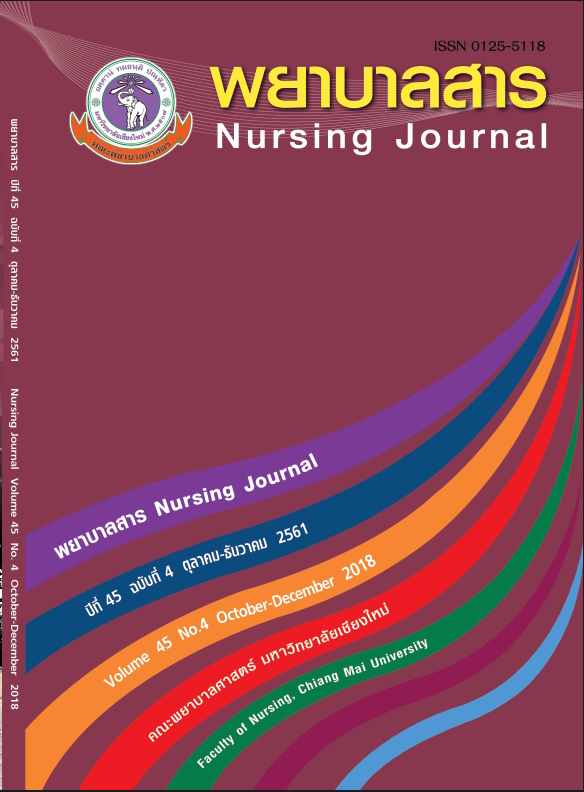ความกลัวการคลอดบุตรของมารดาวัยรุ่นในระยะหลังคลอดและปัจจัยที่เกี่ยวข้อง
คำสำคัญ:
ความกลัวการคลอดบุตร, มารดาวัยรุ่นในระยะหลังคลอด, ปัจจัยที่เกี่ยวข้องบทคัดย่อ
การตั้งครรภ์และการคลอดในวัยรุ่นเป็นภาวะวิกฤติตามวุฒิภาวะ เนื่องจากวัยรุ่นเป็นวัยที่ยังไม่บรรลุวุฒิภาวะทั้งด้านร่างกายและจิตใจ จึงส่งผลให้เกิดความกลัวการคลอดบุตร การวิจัยเชิงพรรณนาแบบหาความสัมพันธ์ครั้งนี้มีวัตถุประสงค์เพื่อ ศึกษาความกลัวการคลอดบุตรของมารดาวัยรุ่นในระยะ หลังคลอดและปัจจัยที่เกี่ยวข้อง กลุ่มตัวอย่างคือมารดาวัยรุ่นที่ผ่านประสบการณ์การคลอดปกติ จำนวน 90 ราย เครื่องมือที่ใช้ในการรวบรวมข้อมูล ได้แก่ แบบสอบถามประสบการณ์เกี่ยวกับความกลัวการคลอดบุตร แบบ B ของ วิจมา วิจมา และซาร์ แปลเป็นภาษาไทย โดย นันทพร แสนศิริพันธ์ (2556) แบบสอบถามความวิตกกังวลต่อสถานการณ์ ของสปิลเบอร์เกอร์ และคณะ แปลเป็นภาษาไทยโดย ธาตรี นนทศักดิ์ สมโภชน์ เอี่ยมสุภาษิต และดาราวรรณ ต๊ะปินตา (ดาราวรรณ ต๊ะปินตา, 2534) แบบวัดความรู้สึกมีคุณค่าในตนเอง ของ โรเซนเบอร์ก แปลเป็นภาษาไทยโดย สุพรรณี สุ่มเล็ก (2538) ปรับปรุงโดยจิรวรรณ นิมิษภาษ (2551) แบบสอบถามการสนับสนุนของพยาบาลในระยะคลอด ของแบรนตัน และคณะ แปลเป็นภาษาไทยโดย ฉวี เบาทรวง และกรรณิการ์ กันธะรักษา (2555) และแบบวัดความเจ็บปวดในการคลอดชนิดที่เป็นตัวเลข ของเมลแซค และคอส วิเคราะห์ข้อมูลโดยใช้สถิติพรรณนา วิเคราะห์ความสัมพันธ์ระหว่างตัวแปรที่ศึกษาโดยใช้สถิติสัมประสิทธิ์สหสัมพันธ์แบบเพียร์สัน
ผลการวิจัยพบว่า มารดาวัยรุ่นในระยะหลังคลอดมีความกลัวการคลอดบุตรระดับรุนแรง (x̅ = 77.30, SD = 25.55) ความเจ็บปวดในการคลอดมีความสัมพันธ์ทางบวกระดับปานกลางกับความกลัวการคลอดบุตร อย่างมีนัยสำคัญทางสถิติ (r = .421, p < .01) ความรู้สึกมีคุณค่าในตัวเอง มีความสัมพันธ์ทางลบระดับปานกลางกับความกลัวการคลอดบุตร อย่างมีนัยสำคัญทางสถิติ (r = -.581, p < .01) ความวิตกกังวลต่อสถานการณ์มีความสัมพันธ์ทางบวกระดับสูงกับความกลัวการคลอดบุตร อย่างมีนัยสำคัญทางสถิติ (r = .818, p < .01) และการสนับสนุนของพยาบาลในระยะคลอดมีความสัมพันธ์ทางลบระดับปานกลางกับความกลัวการคลอดบุตร (r = -.581, p < .01)
จากผลงานวิจัยครั้งนี้มีข้อเสนอแนะว่ามารดาวัยรุ่นในระยะหลังคลอดทุกราย ควรได้รับการประเมินความกลัวการคลอดบุตร พยาบาลและผดุงครรภ์ควรพัฒนากลยุทธ์ที่จะช่วยลดความกลัวการคลอดบุตร โดยลดความเจ็บปวดในการคลอด ลดความวิตกกังวล ส่งเสริมความรู้สึกมีคุณค่าในตนเอง และสนับสนุนสตรีวัยรุ่นในระยะคลอด
References
Anderson, C., & McGuinness, T. (2008). Do teenage mothers experience childbirth as traumatic?. Journal Of Psychosocial Nursing & Mental Health Services, 46(4), 21-24
Alehagen, S., Wijma, K., & Wijma, B. (2001). Fear during labor. Acta Obstetriciaet Gynecologica Scandinavica, 80(4), 315-320.
Baosuang, C.,Kantaruksa, K. (2012). Bryanton Adaptation of the Nursing Support in Labor Questionnaire (BANSILQ). Personal communication.(In Thai)
Chulay M & Burns SM. (2005). AACN Essentials of Critical Care Nursing. New York, Mcgrow-Hill.
Chuahom, U., Sripichyakarn, K., Tungpunkom, P., Klunklin, A., & Kennedy, H. P.(2006). Fear and suffering during childbirth among Thai woman. Thai Journal Nursing Reseach, 11(1), 49-61
Eriksson, C., Westman, G., & Hamberg, K. (2005). Experiential factors associated with childbirth-related fear in Swedish women and men: A population based study. Journal of Psychosomatic Obstetrics and Gynaecology, 26(1), 63–72.
Fenwick , J., Gamble, J., Nathan, E., Bayes, S., & Hauck, Y. (2009). Pre and postpartum levels of childbirth fear and the relationship to birth outcomes in cohort of Australian women. Journal of Clinical Nursing, 18(5), 667-677.
Hofberg, K., & Ward, M.R. (2003). Fear of pregnancy and childbirth. Postgraduate Medical Journal,79, 505-510.
Lowdermilk, D.L., Perry, S., Cashion, K., Alden, K.R. & Olshansky, E. (2016). Maternity &
women’s health care. (11th ed.) St. Louis: Mosby.
Melender, H. L. (2002). Fear and coping strategies associated with pregnancy and childbirth in Finland. Journal of Midwifery & Women’s health, 47(4), 256-263.
Melzack, R., & Kauz, J. (1999). Pain mechanism: A new theory. Science, 150, 974-977.
Neumpadcha, C., Anusornteerakul, S., & Ungpansattawong, S. (2011). The relationships between fear of Childbirth, labour pain and pospartum fatigue. Journal of Nursing Science & Health, 34(4), 56-64 (In Thai)
Niramitpasa, J. (2008). Personal factors, self-esteem, social support, and psychosocial adjustment women with advanced age. (Unpublished master’s thesis). University of Mahidol, Bangkok, Thailand. (In Thai)
Pillitteri A. (2013). Maternal & child health nursing care of the childbearing & childrearing family. (6thed). Philadelphia: Lippincott William & Wilkins.
Polit, D. F. (2010). Statistics and data analysis for nursing research (2nd ed.). New Jersey: Pearson Education Inc.
Phoeiklang, P., Parisunyakul, S., & Sansiriphun, N. (2016). Factors predicting fear of childbirth among postpartum women. Nursing Journal. 43(4). 44-45 (In Thai)
Reid, V., & Meadows-Oliver, M. (2007). Postpartum depression in adolescent mothers: An integrative review of the literature. Journal of Pediatric Health Care. 21. 289-298.
Ryding, E. L., Wijma, B., Wijma, K., & Redhstrom, H. (1998).Fear of childbirth during pregnancy may increase the risk of emergency cesarean section. Acta Obstetriciaet Gynecologica Scandinavica, 77(5), 542-547.
Ryding, E.L., Wirfelt, E., Wangborg, I., Sjogren, B., & Edman, G. (2007). Personality and fear of
childbirth. Acta Obstetricia et Gynecologica Scandinavica, 86, 812-820.
Saisto, T., Salmela-Aro, K., Nurmi, J. E., & Halmesmaki, E. (2001). Psychosochial characteristics of women and their partner fearing vaginal childbirth. Brtish Journal of Obstertrics and Gynaecology, 108(5), 492-498.
Saisto, T., & Halmesmaki, E. (2003). Fear of childbirth: A neglected dilemma. Acta Obstetriciaet Gynecologica Scandinavica, 82(3), 201-208.
Sansiriphun, N. (2013). Fear of childbirth. Nursing Journal. 40(Supplement January). 103-112(In Thai)
Soomlek, S. (1995). A causal model of maternal role mastery among firth time mother. (Unpublished doctor dissertation). University of Mahidol, Bangkok, Thailand. (In Thai)
Thapinta, D. (1991). Reduction of anxiety of staff nurses working with AIDSPatients through cognitive reconstructuring and mindfulness training. (Unpublished master’s thesis). Chulalongkorn University, Bangkok, Thailand. (In Thai)
Wijma, K., Wijma, B., & Zar, M. (1998). Psychometric aspects of the W-DEQ: A new questionnaire for the measurement of fear of childbirth. Journal of Psychosomatic Obstetrics and Gynaecology, 19(2), 84-87.
Zar, M., Wijma, K., & Wijma, B. (2001). Pre and postpartum fear of childbirth in nulliparous and
parous women. Scandinavian Journal of Behaviour Therapy, 30(2): 75-84.
Downloads
เผยแพร่แล้ว
How to Cite
ฉบับ
บท
License
บทความที่ได้รับการตีพิมพ์เป็นลิขสิทธิ์ของวารสารพยาบาลสาร
ข้อความที่ปรากฏในบทความแต่ละเรื่องในวารสารวิชาการเล่มนี้เป็นความคิดเห็นส่วนตัวของผู้เขียนแต่ละท่านไม่เกี่ยวข้องกับมหาวิทยาลัยเชียงใหม่ และคณาจารย์ท่านอื่นๆในมหาวิทยาลัยฯ แต่อย่างใด ความรับผิดชอบองค์ประกอบทั้งหมดของบทความแต่ละเรื่องเป็นของผู้เขียนแต่ละท่าน หากมีความผิดพลาดใด ๆ ผู้เขียนแต่ละท่านจะรับผิดชอบบทความของตนเองแต่ผู้เดียว





